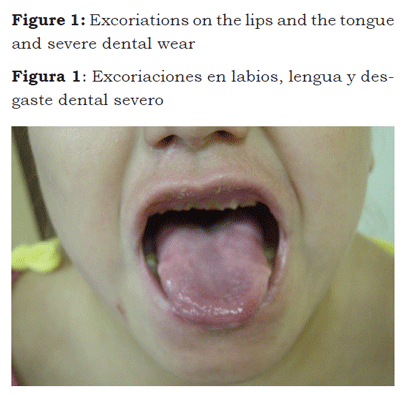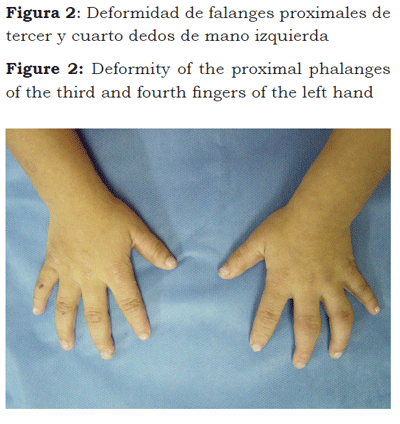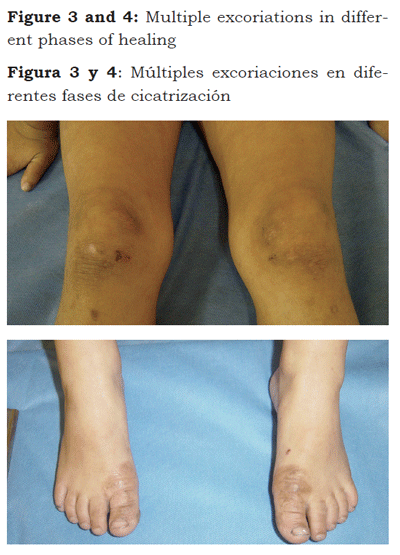Services on Demand
Journal
Article
Indicators
-
 Cited by SciELO
Cited by SciELO -
 Access statistics
Access statistics
Related links
-
 Cited by Google
Cited by Google -
 Similars in
SciELO
Similars in
SciELO -
 Similars in Google
Similars in Google
Share
Colombian Journal of Anestesiology
Print version ISSN 0120-3347
Rev. colomb. anestesiol. vol.38 no.4 Bogotá Oct./Dec. 2010
Reporte de Casos
Congenital Indifference to Pain
Indiferencia congénita al dolor
Adelaida Ãlvarez C.*, Simón P. Aristizábal L.**, Luis Enrique Chaparro***, Lizeth J. RamÃrez B.****, Carlos A. Sarassa V.*****
* Médica, Universidad Pontificia Bolivariana. MedellÃn, Colombia. lalya511@hotmail.com.
** Médico Ortopedista y Traumatólogo, Universidad Pontificia Bolivariana. MedellÃn, Colombia.
*** Médico anestesiólogo. Profesor asociado de Anestesia y Medicina del Dolor, Universidad Pontificia Bolivariana. MedellÃn, Colombia.
**** Médica anestesióloga de la Universidad de Caldas y fellow de Dolor y Cuidado Paliativo, Universidad del Bosque. Bogotá, Colombia.
***** Ortopedista y Traumatólogo Universidad Pontificia Bolivariana, Ortopedista Infantil, Hospital Pablo Tobón Uribe. MedellÃn, Colombia.
Recibido: junio 8 de 2010. Enviado para modificaciones: julio 12 de 2010. Aceptado: julio 24 de 2010.
SUMMARY
Introduction. In the acute phase, pain exerts a natural protective mechanism, However, there are two congenital disorders, in which the main characteristic is a low or nule reactivity to trauma: congenital insensitivity to pain and congenital indifference to pain. The last one is an uncommon condition in which, while not having neurological abnormalities in the pain pathways, the individual lacks of an emotional response to tissue injury.
Objectives. To show the case of a girl with congenital indifference to pain and to make a review of the pathophysiology and diagnostic approach.
Methodology and results. Presentation of a clinical case.
Conclusions. The diagnosis of congenital indifference to pain is basically a diagnosis by exclusión and since a cure for this disorder is not yet known, prevention, education and interdisciplinary treatment are the priority aspects in this entities.
Keywords: Congenital insensitivity to pain, wounds and traumatisms (Source: MeSH, NLM).
Resumen
Introducción. En la fase aguda, el dolor ejerce un mecanismo natural de protección. No obstante, existen dos trastornos congénitos cuya caracterÃstica principal es una baja o nula reactividad al trauma: la insensibilidad congénita al dolor y la indiferencia congénita al dolor. Esta última es una condición poco común en la que a pesar de no existir anormalidades neurológicas en las vÃas del dolor, el individuo carece de una respuesta emocional a la lesión tisular.
Objetivos. Presentar el caso de una niña con indiferencia congénita al dolor y hacer revisión de la fisiopatologÃa y una aproximación diagnóstica.
MetodologÃa y resultados. Presentación de caso clÃnico.
Conclusiones. El diagnóstico de indiferencia congénita al dolor es básicamente un diagnóstico de exclusión y dado que aún no se conoce cura para este trastorno, la prevención, la educación y el tratamiento interdisciplinario son lo primordial en estas entidades.
Palabras clave: Insensibilidad congénita al dolor, heridas y traumatismos (Fuente: DeCS, BIREME).
INTRODUCTION
Case reports have been and will be for a long time an outstanding tool for the description of exceptional cases in the literature and, as well, a very important pedagogical strategy in the practice of anesthesia and pain medicine (1). Pain, in turn, is one of the main causes of consultation. If we ask someone if he would like to live a life free of pain, the answer will probably be affirmative, but when we analyze with more detail this answer, the implications that such condition would generate are obvious, since, at least in the acute phase, pain exerts a natural protective mechanism against injuries that may affect human well-being (2).
Congenital indifference to pain is an infrequent condition in which, despite not having neurological abnormalities in the pain pathways, the individual lacks of emotional response in cases of tissue injury (3). This condition puts at risk those who suffer from it since very early ages. Children may suffer serious injuries, such as fractures, burns or infections, without having pain, thereby being faced to potencial complications and sequelae. With the recent advances in the genetics of pain neurobiology, there is a growing interest in understanding the underlying mechanisms of this disorder.
The case report of a patient who has been exposed during her early childhood to multiple musculoskeletal and cutaneous injuries is described below.
CASE REPORT
Four years old mestizo girl, who consulted an orthopedic service for compression fractures of the fingers on her left hand, which were initially managed with immobilization, but there was no adherence to treatment, leaving thereby residual deformities. A history of multiple musculoskeletal and cutaneous traumas of the trunk and the limbs was documented during the anamnesis, as well as a mild craneo-encephalic trauma after falling down from a second floor, self-inflicted injuries in fingers and oral cavity and an abnorfimal behavior against potentially harmful activities: she is indifferent to venopunctures, likes to extinguish candles with the fingers, touches switched-on irons, takes very hot drinks and rolls down the stairs. All her injuries had been difficult to heal because of self-mutilation and lack of adherence to treatment.
The patient is the third child of parents in second degree of consanguinity (first cousins), with satisfactory prenatal controls and normal ultrasound examinations. The mother had a spontaneous vertex delivery at term without complications, institutional. The patient weighed 2.500 g at birth and measured 48 cm. Her neuropsychomotor development was normal. As pathologic antecedents she had dermatitis, mild rhinitis and asthma that have not required treatment. She has allergic antecedents with an urticariform reaction to dipyrone. Surgical and transfusion antecedents are negative, and she has been fully immunized for her age. The family history includes a learning disorder (paternal uncle) and mental retardation (paternal cousin).
On physical examination the patient had normal vital signs, as well as the cardiopulmonary, abdominal and genitourinary evaluation. There where detected lesions in the lips and the tongue compatible with trauma due to bite, and severe dental wear without septic foci (figure 1). Her limbs show deformity of the proximal phalanges of the third and fourth fingers of the left hand, secondary to consolidated fractures with limitation of the mobility of the interphalangeal joint. The fourth finger of the left hand has a varus angulation of 10º. The other fingers have scars in the fingertips (figure 2). Articular hyperlaxity was also detected. She has dry skin without alterations in sweating and multiple excoriations in different phases of healing, as well as some bruising with no defense evoked response to pressure (figures 3 and 4). On the neurologic examination she appears conscious, alert, and oriented, with appropriate contact, interaction and verbalization, without involvement of craneal pairs. Osteotendinous reflexes are normal and symmetric and corneal reflex is present. Her deep and superficial sensitivity is preserved, and she adequately discriminates between cold, heat and pressure, but without an evoked response to boiling water. There are no signs of focalization.
The following paraclinical tests were done to the patient:: nuclear magnetic resonance (NMR) read as normal by a neuroradiologist Brainstem auditory evoked potentials (BERA) normal. Electroencephalogram (EEG) normal. Electromyography and nerve conduction velocity (EMG and NCV) of the four limbs with no evidence of sensorial or motor polyneuropathy. Sympathetic skin response test normal. The anatomopathologic study of the sural nerve was reported within normal limits by a neuropathologist.
The patient was evaluated by a neuropsychiatrist, who made an additional diagnosis of attention déficit and hyperactivity disorder, which, associated with the disorder of congenital indifference to pain, increases the posibilitéis of suffering serious injuries, and therefore, an interdisciplinary management of her pathologies was initiated. After the analysis of these paraclinical tests and the clinical condition of the patient, it was possible to establish the diagnosis of congenital indifference to pain.
Discussion
The pain reactivity disorders have been divided into two groups: congenital and acquired. Within the congenital âdescribed by Dearborn in 1932 (4)â there are two subgroups: the first includes patients with congenital indifference to pain, in whom the sensory pathway is intact, but the interpretation or perception as a painful sensation is absent. The second includes patients with congenital insensitivity to pain, in whom the pain stimulus is not properly transmitted to the central nervous system due to an alteration of the discriminative ability of the sensory pathways (2). In turn, the congenital insensitivity disorders gather together a group of heterogeneous clinical patterns which are called HSAN, by their acronym of hereditary sensory and autonomic neuropathy. The classification was incorporated by Dyck in 1983 and is complemented with different genetic studies (5). Five types of HSAN have been identified, and this classification is based on the hereditary pattern, the clinical features and the most affected neuronal systems: HSAN I, hereditary sensory radicular neuropathy; HSAN II, impairment of the discrimination of tactile and pressure stimuli; HSAN III, familial dysautonomia (Riley-Day Syndrome); HSAN IV congenital insensitivity to pain with anhidrosis, and HSAN V (3).
Among the acquired disorders are included the pain asymbolia, painful hemiagnosia, and analgotimia. The characteristic of the acquired disorders is that the lesions in different parts of the brain are responsible for the clinical manifestations of the patient (2,5).
When talking about the components of the perception of pain it is indispensable to know the two major ascending pathways: the lateral system that passes through the lateral thalamic nucleus until the somatosensory cortex, responsible for the sensory-discriminative component, and the medial pain system, which passes through the medial thalamic nucleus until the anterior cingulate an insular cortex, responsible for the affective response to pain stimuli (5). Patients with peripheral neurophaties have affected both pathways and most of them have a type of hereditary sensory and autonomic neuropaty (2).
The main differential diagnosis of congenital indifference to pain should be made with congenital insensitivity to pain, specifically with HSAN V. This hereditary sensory and autonomic neuropathy type V is a rare condition characterized by the absence of perception and normal reaction to pain and temperature, but with preservation of the perception of touch, proprioception and vibration (2).
Insensitivity is evident since early childhood with frequent fractures, ulcers and burns. Autonomic manifestations are variable. In this type of syndrome the primary pathological affection is in the small caliber neurons responsible for the transmission of pain and temperature and in the autonomic neurons (4). This can be evidenced in the sural nerve biopsy as a severe loss of small myelinated fibers, including the A delta fibers, and a decrease in the number of unmyelinated fibers (2,3). It is known that these individuals have been misdiagnosed with congenital indifference to pain before the existence of morphological studies of the peripheral nerves (2), since the great difference between congenital insensitivity and congenital indifference to pain lies in that individuals with congenital insensitivity to pain have the described alteration in the sural nerve biopsy and individuals with congenital indifference to pain exhibit a completely normal
biopsy of peripheral nerve.
Patients with congenital indifference to pain do not show a withdrawal response to normally painful stimuli, and thus they can withstand burns and other injuries without showing any reaction. However, the sensory examination is completely normal (6). One of the cardinal symptoms is their lack of interest or concern for the injuries (2). As already explained above, the peripheral nerve biopsy is completely normal. It is considered that these individuals have a deficit in affective-emotional response to pain, rather than a deficit in the discrimination of painful stimuli (2).
Another disorder that must be ruled out is pain asymbolia. Patients with this pathology have lesions in the anterior cingulate and insular cortex that produce a loss of the affective-emotional component of pain and lesions in the primary and secondary somatosensory cortex which generate loss of discrimination to the sensory-discriminative component of pain (5). Imaging studies are required to make the differential diagnosis with congenital indifference of pain
Each paraclinical test performed to the patient (NMR, BERAS, EEG, electrodiagnostic test and sympathetic skin reaction test) was normal and allowed to exclude acquired lesions as the responsible for the clinical presentation (2). This supports the diagnosis of congenital indifference to pain, which is basically a diagnosis by exclusion.
While the normal morphology in the sural nerve biopsy with electron mycroscope in patients with congenital indifference to pain rules out the selective absence of unmyelinated nociceptors, this exam does not rule out the possibility of other chemical or structural abnormalities, for example, alterations in neurotransmitters or in central sensory pathways (2).
Although the pattern of genetic transmission in the congenital indifference to pain is not yet known, it may be autosomal recesive (3). In the reported case, it was documented the existence of second degree consanguinity (first cousins) between the parents of the patients, which increasesâat least theoreticallyâ the possibility of phenotypic expression of the defect.
Since a cure for any of these disorders of insensitivity of indifference to pain is not yet known, the top priority is the prevention and the education of both the patient and the family and an interdisciplinary treatment that includes the medical staff and the services of psychology and functional rehabilitation.
Acknowledgements
We are grateful to Beatriz Aguirre L. (Physical Medicine and Rehabilitation) for her collaboration and support in the realization of this case report and to Luisa Fernanda Mesa F. (Physical Medicine and Rehabilitation Resident) for the realization of the EMG, the NCV, and the sympathetic skin response test.
REFERENCES
1. Chaparro LE. Uso de los casos clÃnicos como estrategia didáctica en la enseñanza de anestesia. Rev Col Anest. 2004;32(4):281-4.
2. Nagasako EM, Oaklander AL, Dworkin RH. Congenital insensitivity to pain: an update. Pain. 2003;101: 213-9.
3. Karkashan EM, Joharji HS, Al-Harbi NN. Congenital insensitivity to pain in four related Saudi Families. Pediatric Dermatol. 2002;19(4):333-5.
4. Dearborn G. A case of congenital general pure analgesia. J Nerv Ment Dis. 1932;75:612-5.
5. Vicente-Fatela L, Acedo MS. Trastornos de la reactividad al dolor. Rev Soc Esp Dolor. 2004;11:31-7.
6. Hirsch E, Moye D, Dimen JH. Congenital indifference to pain: Long term follow-up two cases. South Med J. 1995;88:851-7.
1. Chaparro LE. Uso de los casos clínicos como estrategia didáctica en la enseñanza de anestesia. Rev Col Anest. 2004;32(4):281-4. [ Links ]
2. Nagasako EM, Oaklander AL, Dworkin RH. Congenital insensitivity to pain: an update. Pain. 2003;101: 213-9. [ Links ]
3. Karkashan EM, Joharji HS, Al-Harbi NN. Congenital insensitivity to pain in four related Saudi Families. Pediatric Dermatol. 2002;19(4):333-5. [ Links ]
4. Dearborn G. A case of congenital general pure analgesia. J Nerv Ment Dis. 1932;75:612-5. [ Links ]
5. Vicente-Fatela L, Acedo MS. Trastornos de la reactividad al dolor. Rev Soc Esp Dolor. 2004;11:31-7. [ Links ]
6. Hirsch E, Moye D, Dimen JH. Congenital indifference to pain: Long term follow-up two cases. South Med J. 1995;88:851-7. [ Links ]











 text in
text in 




